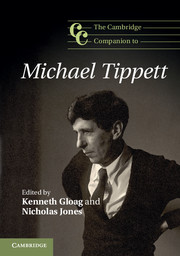Preface
Since his death in 1998 the music of Sir Michael Tippett continues to be performed and studied, with works such as the Concerto for Double String Orchestra (1938–9), A Child of Our Time (1939–41) and The Midsummer Marriage (1946–52) achieving a significant public profile as well as continued critical scrutiny. The wider recognition and reception of Tippett and his music was further extended through the centenary celebrations of 2005, which drew attention to several other works such as the opera The Knot Garden (1966–9), which received several performances.
However, given the wide range of music that Tippett composed during a long career that extended for much of the twentieth century, there is a great deal of music by him that is not being performed and has not been discussed extensively in the literature, and as Arnold Whittall documents in the first chapter, following a productive period around the late 1990s, there has not been much published on Tippett and his music since then. This Companion cannot fully address this absence, but it does provide commentary on Tippett’s music beyond just the already well-known works and it raises issues that were pertinent to Tippett at many key points in his career.
Each of the contributors brings to this book their own interests and experiences, formed through close study of, and research on, Tippett and his music. Such interests and experiences include deep knowledge of specific archive materials – letters, documents – and often close analytical study of specific works. Many contributors draw on Tippett’s own writings about music, and the published selected correspondence, and all engage with, and reflect upon, the existing literature.
However, as is consistent with the Cambridge Companion series, we seek to direct this knowledge and expertise towards a wide readership, making accessible scholarship that will enrich the listening experience of the music and construct a context for it. But we also hope that this book can present some issues, and suggest directions, that can influence both the future scholarly understanding of this music and the wider perception of it.
Part I engages with the contexts and concepts within which Tippett is situated and through which the music can be interpreted. Tippett was a product of the twentieth century and, in the first chapter, Arnold Whittall reflects on the polarities of that century and Tippett’s position within it. The question of the extent to which Tippett may, or may not, be a product of a set of traditions defined as English is explored by Christopher Mark, while Suzanne Cole discusses Tippett’s often practical involvement with early music. Tippett was always aware of the wider world beyond his own compositional experiences and Joanna Bullivant examines his involvement in specific political activities in the 1930s along with his dialogue with the composer Alan Bush. If political engagement was important for Tippett at that time questions of personal, sexual identity were also crucial and, as Suzanne Robinson highlights, such issues remain directly relevant to our understanding of the music. Tippett provided a great deal of written commentary about himself, his music and other factors. These writings are returned to at many different points in this book, but Thomas Schuttenhelm’s contribution deals directly with such texts as a way of reconstructing and interpreting Tippett’s own understanding of his creative imagination and process.
As a composer Tippett always related to historically defined genres – opera, string quartet, symphony, concerto, sonata – and Part II of the book traces his compositional activity in each genre, or, in the case of vocal works as a loose grouping, through discussion of individual works. In most genres Tippett’s music extends across his long career and each contributor gives an account of how, within a specific genre, different works fit into a larger picture. However, although this becomes a recurring pattern, each author has an individual interpretation of how that picture is constructed within the selected genre. And yet, one common factor in Chapters 8 to 13 is the difference of Tippett’s music composed after King Priam (1958–61) in comparison to the music which came before, with the nature of the ‘great divide’ that this opera represents discussed in some detail by Iain Stannard in Chapter 7. As David Clarke correctly reminds us, ‘there was always a tension in Tippett’s music between coherence and the inchoate and in this light we might see connections and continuities between different periods of his oeuvre’.1 As becomes evident through this part of the book, there are continuities across different works and different periods of Tippett’s career, but there are also dramatic differences, between the essentially tonal idioms of, for example, the Concerto for Double String Orchestra and The Midsummer Marriage, and the post-tonal soundworld of King Priam and beyond.
We hope this book will help readers to navigate their own path through Tippett’s long and remarkable career, shedding new light on some works and issues while bringing others into a clearer focus.
Notes
1 , review of , Tippett: A Child of Our Time (Cambridge University Press, 1999), Music & Letters, 82/2 (May 2001), 344.

